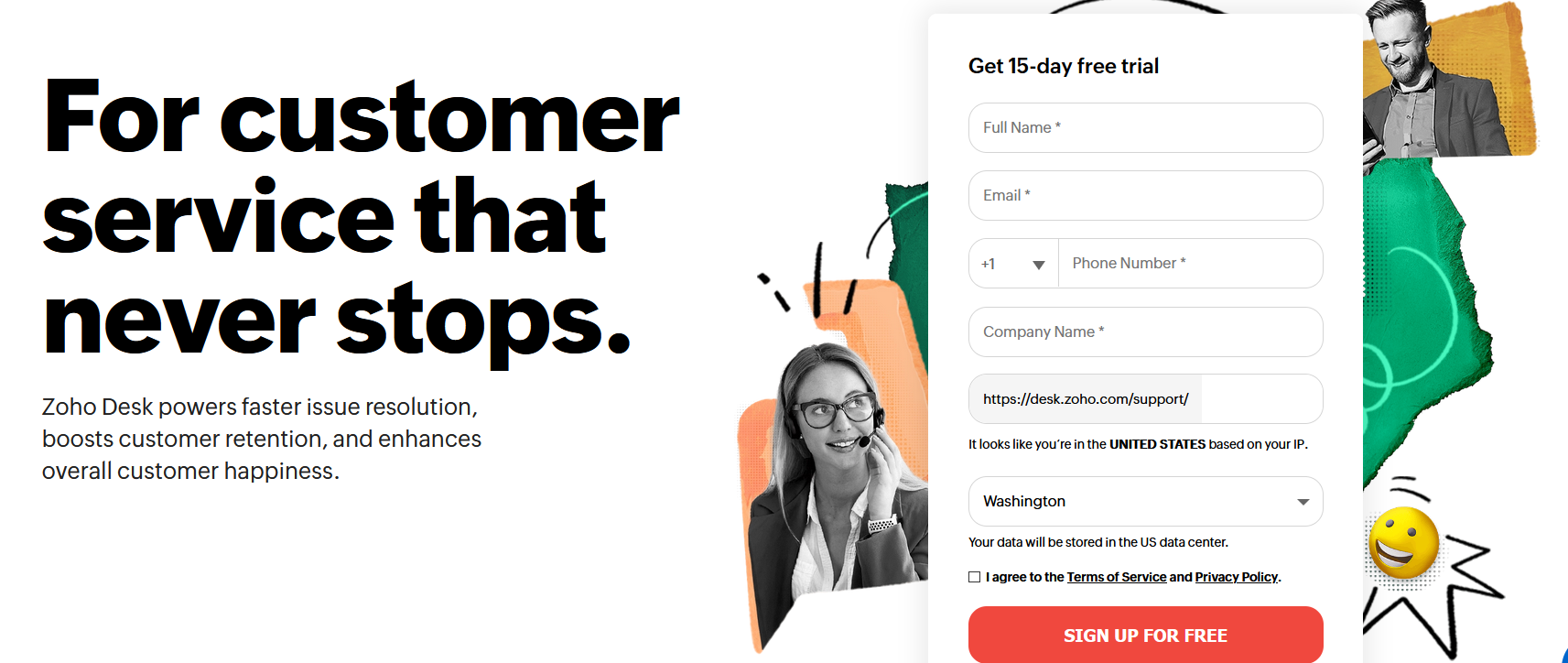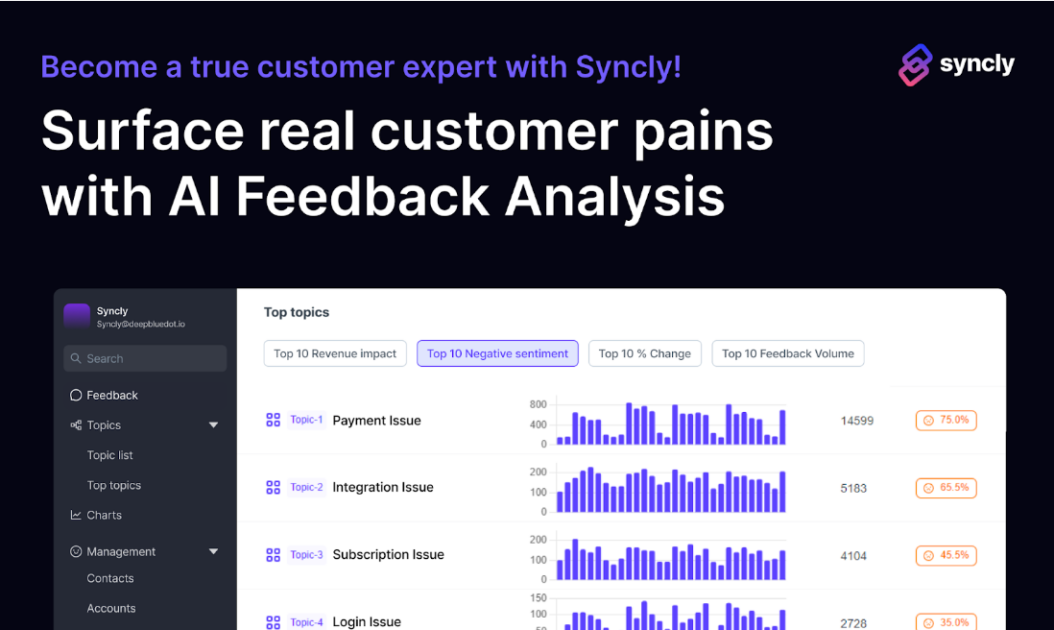Customer Experience Software is designed to help you deliver better experiences to your customers so they can stick with your brand. Using this, you can also retain more customers and boost customer loyalty.
It helps you understand how customers perceive your products/services and whether they are satisfied with your offerings or not. And if you do not know these things, how can you improve your deliverability?
So, if you assume that they are satisfied by just looking at the sales, you are missing something. You may get even higher sales and revenue if you can map customer experiences, what they feel about your offerings, and how their journey has been. In turn, you can shape your products/services better to boost customer satisfaction rates, brand advocacy, and loyalty.
Below are some of the best customer experience software to help you avail yourself of these benefits.
- 1. Zoho Desk
- 2. Freshdesk
- 3. Zendesk
- 4. Syncly
- 5. HubSpot
- 6. Adobe
- 7. Qualtrics
- 8. Medallia
- 9. Contentsquare
- 10. Clarabridge
- 11. Nice CXone
- 12. Genesys
- Show less
1. Zoho Desk
Satisfy every customer with your service by using the power of the customer context to improve productivity, promotion, and management with Zoho Desk. It enables you to provide a great customer experience by tracking every request across brands, channels, departments, products, etc., and managing tickets.

It allows you to be available for customers on multiple channels like phone, chat, email, website, and social media to respond faster. Create different service portals for various brands and organize the help desk to show your company’s structure.
Give more power to your team with the contextual AI, i.e., Zia. You can set solutions so that Zia will speak to your customers, find solutions for them, and train Zia to perform necessary actions for your business operations. In addition, monitor statistics, analyze sentiment, and opt for Zia notifications whenever required.
Moreover, you can offer self-service to the customers by embedding a knowledge base and user community. Empower agents with work modes, response editor, CRM integration, and many more options to enhance growth. In addition, automate all the repetitive activities to save effort and time.
You can integrate with other software that your business uses and extend the help desk to fulfill business needs. Zoho Desk’s SDKs will help you build mobile apps, and you can get every insight of your team through dashboards and reports.
Maintain a proper status of every ticket from creation to closure. You can use or create templates for emails, ticket forms, and notifications. Protect each data of the customer while informing your team what they need. Choose from different plans and take a FREE trial for 15 days.
2. Freshdesk
Freshdesk is the omnichannel customer experience software that is powerful and simple. It allows context-based conversations on chat, web, social media, phone, and email from a platform wherever you use a cellphone or laptop.
Freshdesk’s automation will take care of support operations so that you spend more on delivering a better customer support experience. Set up bots and build knowledge base widgets to help customers or agents find their required answers quickly.

You can track team performance, identify bottlenecks, and measure customer satisfaction via reports and customizable dashboards from the insights. Its intuitive process helps your team continue work without excessive hand-holding.
Intuitive and straightforward UI helps boost productivity by allowing the team to support the customers without distractions. Provide details to start your 21-day FREE trial and learn more about the software by experiencing its features and usage.
3. Zendesk
Get the complete customer support solution to provide a better experience with Zendesk and grow your business. Zendesk helps your customers as well as your teams to make things easier and scalable. It allows you to offer support to the customer in a convenient way as they are looking for.
Let your customers use any means of communication such as live chat, social, email, voice, messaging, etc., so that they can connect with you whenever they need and wherever they are. You can reduce resolution time for the agents by building a community forum and help center so that customers resolve their issues at their own pace.

Use AI-powered bots and automation to receive the context and ensure customers don’t repeat themselves. Zendesk offers easy-to-use and quick to setup, allowing admins, internal teams, and agents to do their work properly. Plus, respond to and manage customer context from a unified workspace, including over 1000 pre-built integrations.
Work smarter with intelligence and routing to collect details to reduce data entry. Boost agent efficiency with collaboration tools that connect with external and internal partners. You can also integrate all customer data through integration options, including no-code and code functionality.
Create a single unified view and manage it throughout the customer journey. Make it more sensational with actionable insights to analyze, monitor, and take necessary steps according to your customer’s needs.
Its pricing starts from $49/month/agent, billed annually, and a FREE trial is also available.
4. Syncly
Syncly is an AI-powered customer feedback analysis tool that provides holistic visibility based on everyday customer interactions. Syncly helps users understand what needs to be done to elevate to a 5-star customer experience. With integrations offered across various customer communication tools (Zendesk, Gorgias, Slack, Intercom, Gong, Front, CSV files etc.), Syncly ingests and categorizes customer feedback automatically.
Users can leverage Syncly AI throughout the customer feedback management journey. With AI-powered Insight, you can identify the most critical issues at each stage of the user journey without having to manually ingest and analyze every customer interaction.

Syncly can also pinpoint positive and negative sentiment drivers, and provide instant action items to address the issues at stake based on your data. With Customer AI, users can monitor sentiment trends by account and by individual user, proactively engaging unhappy customers that need their issues resolved before they become at risk.
Syncly can also help your team breakdown silos across different functions and rally the team around the unified customer visibility. Users can easily share Syncly analysis along with charts, graphs or action items across the organization.
Sign up for a demo and receive a free analysis of what’s the critical customer issues.
5. HubSpot
HubSpot’s customer service management software helps you scale customer support, unite your teams on an easy-to-use and powerful platform, and offers services that retain and delight customers. It includes help desk automation, conversational tools, knowledge base, reporting, customer feedback surveys, etc., powered by the CRM to give a unified view of every customer interaction.

HubSpot brings every service channel and data to a single place and helps scale your support via self-service and automation. It gives you more time for active service that helps grow your customer base. Plus, you can add automation and routing to the tickets to create the help desk, prioritizing the critical issues first.
Furthermore, deploy CSAT, custom surveys, NPS, and CES to gather feedback to enhance customer experience. You can also monitor your business health by creating cross-objects, single objects, or custom funnel reports.
You can choose the FREE plan or premium plan starting at $45/month.
6. Adobe
Get content-led experiences and personalization with Adobe Experience Manager, which combines the power of digital asset management with a content management system. It helps you ensure consistent, personalized content for your customers using Adobe Experience Manager Sites. Additionally, you can build and manage digital experiences in various channels using automated tools for effortless scaling.

Adobe Experience Manager Assets lets you focus on delivering a better experience instead of continuously searching for content and adapting it. It offers smart tools and automation to source, adapt, and provide digital assets across channels and audiences.
You can create responsive forms that users can easily e-sign and complete and make the customer journey a joyous ride. This cloud-native enterprise-level content management system is cost-efficient and offers optimal performance, security, and high service level agreement (SLA).
7. Qualtrics
Qualtrics helps you turn your customers into loyal flag-bearers by offering them with high-quality service they expect of you. Qualtrics CustomerXM gives you the power of the ultimate listening engine, analytics & predictive intelligence, and closed-loop actioning capabilities so that you can understand the customers’ experiences to take meaningful actions.

With 128 data sources and 27 channels in a single platform, you can meet customers online wherever they are. It helps you capture true feedback and get a full view of customers’ feelings and desires. CustomerXM sends recommended actions automatically to the teams in the tools they use. Drag-and-drop integrations trigger the actions automatically in the ticketing systems, CRM, messaging apps, etc.
The enterprise-grade platform offers compliance, security, and manageability for smooth business operations. Plus, the management tools control department and team access to ensure the right data flows to the right person. CX program also includes a dashboard, feedback collection, and program roadmaps and is tested and customized for different industries.
8. Medallia
Medallia is the customer experience software that drives loyalty at each point along the journey of a customer. It helps you analyze and capture signals, predict behavior, and create experiences that let customers want more of your products/services.
Engage with customers on multiple channels such as SMS, messaging, social feedback, reviews, web intercepts, mobile-in-app feedback, IVR systems, chat and call transcripts, and IoT devices. Capture customers’ voices through the employees by allowing frontline employees to give ideas, suggestions, and feedback on every experience.
You will find many products like feedback management, Medallia Social, Medallia Digital, employee ideas, Medallia conversations, integrations, Medallia Digital Anywhere, and Zingle. You can also create a profile for the customers to get a 360-degree view of everything.

Get thorough insights to know customer engagement, predict behavior, understand the model attrition risk, and gain opportunities for improvement. Group similar customers into segments to resolve their issues. With CX profiles and CX journeys, you can also get customer lifecycle insights.
Medallia Athena helps you apply machine learning and AI to uncover trends and patterns, predict customer behavior, and analyze journeys. Text Analytics allows you to suggest actions to improve every experience and enhance business growth. You can create dashboards to start monitoring customer sentiment and experience.
Allow continuous sync to get every alert in time to deliver feedback and check whether data is displayed correctly in real-time to all the users. Allow employees to respond to customers immediately with the pre-built template and ensure they resolve all the issues in true time. You can have either B2C or B2B customer experience, employee experience, and product experience.
9. Contentsquare
Analyze the report to see your company’s performance by checking customer journeys with Contentsquare. Discover a customer’s complete experience, like how they progress through the site, from entry to exit, and page by page. With the journey mapping, you can visualize aggregate data from one hundred percent of the journeys.

Aggregate data will show the pages they have visited and also the orders they placed. At a glance, you can see the typical journey anomalies like looping behaviors and unexpected drop-offs. You also have the option of using segments to focus on particular things in detail.
Directly move to Behaviour Analysis or Zone-based Heatmaps for the insights. Check the pages where visitors visited before arriving at a particular page and events like 404 site errors, Voice of Customer feedback, conversion, or site abandonment.
10. Clarabridge
Go beyond NLP, data categorization, and sentiment to measure emotion, effort, root cause analysis, and intent using machine learning and rule-based approaches to AI with Clarabridge. It offers text analytics to learn what every customer is saying to enable a contextual understanding of the comments.
Whether it is emails, calls, reviews, chats, surveys, ratings, forums, or social interactions, Clarabridge connects with many sources and collects every feedback in one place. Data connectors gain insights from each source of feedback to detail the entire journey of a customer.

Clarabridge Effort Score automatically understands the rate of effort the customers put forth so you can make informed decisions. It also has the ability to capture degrees of variation accurately on its eleven-point sentiment scale. You can categorize every data into related issues and resolve the issues faster.
Clarabridge has many templates that make the work easier concerning data categorization and aid in easy reporting and promoting insight discovery. Use emotion analysis to empathize with customers by understanding how they feel engaging with you and your products/services.
It uses AI-powered analysis strategies to know 21 kinds of intents relevant to customer experience analytics, including isolate requests, cries for help, praise, legal disclosures, and churn.
11. Nice CXone
Nice CXone is a cloud-based platform that strives to improve customer-company relationships and enhance overall user experience.

Brand loyalty is a crucial aspect of building business, and ensuring your clients are happy to be associated with your company goes a long way in cementing the relationship.
Nice is a CX platform that leverages the power of Artificial Intelligence to deliver the ultimate customer experience across all involved communication channels.
The functionality of Nice CXone can be divided into 4 elements. all hosted on an open cloud foundation:
- Workforce Optimization
- Omnichannel Routing
- Customer Analytics
- Automation and Artificial Intelligence
It ensures a holistic view of all key metrics for a better understanding. Ensuring customer satisfaction is essential, but so is taking care of your employees.
Nice CXone’s WFO (workforce optimization) is a great feature that allows organizations to manage and track their employees’ performance.
| Pros ✅ | Pros ❌ |
|---|---|
| Personalized IVR. | Reporting tools need improvement in flexibility as there is limited space for modification. |
| AI assistance for agents. | The contact detail report is available for 90 days only. Sometimes, the companies need to check older records. |
| Interactive dashboard for better workflow management. |
Nice CXone’s pricing model is very accommodating. Depending on the front they are manning, you can buy specialized plans for individual agents: digital – $71, voice – $94, or omnichannel – $110.
For more inclusive plans that cover analytics and management, you can choose from the following suites – Essential, Core, and Complete priced at $135, $169, and $209, respectively.
12. Genesys
A complete CX cloud contact center solution, Genesys aims to simplify how customers interact with a business. It is active in over 100 countries, catering to almost 7,000 companies.

Its popularity can be attributed to many factors, but what sets it apart from other platforms is its stringent security measures, like AES 256 and TLS encryption. Genesys is secure and reliant.
Stop worrying and let this tool handle your conversations across all your communication channels, like text, call, email, or social media interactions.
Not many tools have the WEM (workforce engagement management) feature, but Genesys tries to elevate the agent experience to serve the client better.
| Pros ✅ | Pros ❌ |
|---|---|
| Live dashboard for real-time analysis. | Limited to larger budget enterprises |
| Seamless integration with other platforms. | Overwhelming options for small businesses |
| Interactive and easy-to-use Interface. | Potentially challenging for basic users |
| AI takes up routine tasks for better workforce engagement management. |
Genesys has very competitive price models. The basic voice plan – Genesys Cloud 1, is capped at $75 and has all the basic features needed to get started. The plans expand to include digital and WEM solutions as you go up. These are:
- Genesys Cloud 2 (digital): $95
- Genesys Cloud 2 (digital + voice): $115
- Genesys Cloud 3 (digital + WEM): $135
- Genesys Cloud 3 (digital + WEM + voice): $155
You can compare other feature-oriented plans through the special feature matrix, a plan comparison sheet for a bird’s eye view.
Next, I will explain what customer experience software is and how it can benefit your business. So, let’s start!
What is Customer Experience Software?

Customer Experience software is a tool that helps you provide exceptional customer experience by allowing you to collect, organize, manage, and track customer feedback. As a result, you can optimize your customer relations, sales, and product/service quality.
It is equipped with valuable capabilities such as customer analytics, feedback, contextual help, and a content management system. In addition, the software can predict customer retention, repurchase rate, and loyalty to your brand. It will also bring together essential ingredients such as strategy, resources, and technology to help you improve your business standards.
Customer experience software stores all the data regarding customers, their interaction with your brand, purchases, surveys, etc., to give you an idea about their journeys from being a visitor to a customer and their satisfaction levels. You can determine which strategy is working or not working and learn which areas need improvement.
How is Customer Experience Management Different from Customer Service?
Customer experience management is different from customer service, and so are their respective tools. The former is reactive and applicable when customers face challenges with your products/services. On the other hand, customer service platforms proactively cater to customers’ needs, and ensure they do not face challenges by anticipating events.
Why do you need Customer Experience Software?
Customer experience software bridges the gaps between a business and its customers. Attracting customers is important, but retaining them keeps a business going, which is possible only if you provide best-in-class services or products that customers cherish.
So, here are the benefits your business can avail of by choosing customer experience software:
Increasing customer satisfaction
Customer experience software helps you map the satisfaction level of your customers, their challenges, and their expectations through genuine feedback. You can analyze the feedback to improve your offerings, ensuring they do not face those challenges again. This, in turn, will boost your satisfaction rates, sales, and revenue.
Reducing churn
Competition is increasing in all business verticals, and you would never want to lose your customers to them due to inferior products/service offerings. The only way to understand whether or not they will stick with your brand is by taking their genuine feedback using the software. It will help you improve your offerings and provide an impression that you actually care for your customers and are willing to make improvements for them. This way, you can reduce customer churn rates.
More engagement rates
If you can improve your products/service, you will see visible changes in your engagement levels. You can attract more customers while retaining the previous ones. Customer experience software also tracks the retention rates, new customer acquisition rates, and overall conversion rates to help you measure the success rates.
Enhanced brand reputation
By tracking reviews in real time, the software lets you address negative feedback quickly and improve your deliverability. At the same time, you can promote positive feedback to attract more customers. These ways are essential to build trust with your target audience and customers and increase your brand reputation. In addition, when your customers are satisfied with you and trust you, they become your loyal customers and the biggest brand advocates.

Tips for managing the customer experience
✔️Prompt and Responsive Communication: Ensure that you respond to customer inquiries, concerns, and feedback in a timely manner. Prompt communication shows that you value their time and are committed to addressing their needs.
✔️Consistency Across Channels: Deliver a consistent experience across all customer touchpoints, whether it’s in-person interactions, phone calls, emails, or online chats. Consistency builds trust and reinforces your brand image.
✔️Proactive Problem Resolution: Anticipate and address customer issues before they become major problems. Implement proactive measures such as regular check-ins, surveys, and monitoring of customer feedback to identify and resolve issues promptly.
✔️Continuous Improvement: Regularly gather customer feedback and use it to improve your products, services, and overall customer experience. Embrace a culture of continuous improvement, striving to exceed customer expectations and deliver exceptional experiences.
✔️Personalization and Customization: Tailor your interactions and offerings to meet the specific needs and preferences of individual customers. Personalization enhances the customer’s experience, making them feel valued and understood.

How to choose the best customer experience management software?
When choosing the best customer experience management software, it’s important to consider the following key features:
- Feedback Collection and Analysis: Look for software that simplifies the collection of customer feedback through surveys, reviews, or feedback forms. It should also provide powerful analysis tools to gain valuable insights from the feedback data.
- Omnichannel Support: Select a platform that supports multiple channels, such as email, chat, social media, and phone, enabling you to deliver consistent customer support across different touchpoints.
- Customer Journey Mapping: Find software that allows you to map and analyze customer journeys, visualizing their interactions and identifying areas for improvement to enhance the overall customer experience.
- Integration Capabilities: Ensure that the software integrates smoothly with your existing systems, like CRM software or help desk platforms. The integration enables a unified view of customer data and streamlines processes, leading to a personalized customer experience.
- Real-time Analytics and Reporting: Choose software that provides real-time analytics and reporting, giving you instant visibility into key customer experience metrics. This helps you monitor performance, detect trends, and make data-driven decisions to optimize the customer experience.
Conclusion
Customer is king, and they deserve to be treated like one. Therefore, it’s crucial to learn their experience with your brand and products/services. Use customer experience software like the ones I mentioned above to increase customer satisfaction levels, reduce churn, boost engagement, and enhance your brand reputation. Here’s how to use external customer data platforms to grow your business and map your customer journeys to improve onboarding.
You can trust Geekflare
At Geekflare, trust and transparency are paramount. Our team of experts, with over 185 years of combined experience in business and technology, tests and reviews software, ensuring our ratings and awards are unbiased and reliable. Learn how we test.

